
The Tissamaharama Raja Maha Vihara is an ancient Buddhist temple in Tissamaharama, Southern Province of Sri Lanka. It was one of the four major Buddhist monasteries established in Sri Lanka, after the arrival of Arhant Mahinda Thera to the country. The site of the Tissamaharama Raja Maha Vihara was consecrated by Lord Buddha himself, who spent some time in meditation there with 500 arhats, during his third visit to the island. Tissamaharama monastery had been recognized as a pre-eminent Buddhist educational center of the southern Sri Lanka from the 3rd century B.C. to the 11th century A.D. The Tissamaharama Dagoba which is situated in the premises of the monastery is one of the largest stupas in Sri Lanka. The present chief incumbent of Tissamaharama Raja Maha Vihara is Ven. Devalegama Dhammasena Nayaka Thera.
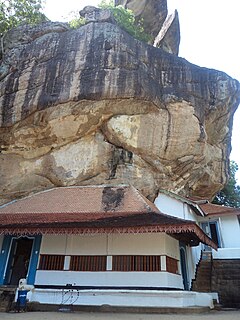
Ridi Viharaya or Silver Temple is a 2nd-century BCE Theravada Buddhist temple in the village of Ridigama, Sri Lanka. Built during the reign of Dutthagamani of Anuradhapura, the temple is considered as the place where the silver ore, which provided silver to complete Ruwanwelisaya; one of the largest stupa in Sri Lanka, was discovered. According to the chronicles Mahavamsa and Thupavamsa, the Ridi Viharaya complex was built in gratitude for helping him cherish his dream of completing Ruwanwelisaya.
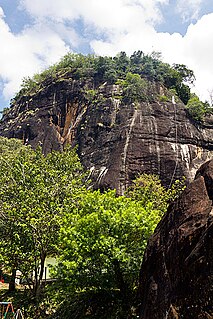
Mulkirigala Raja Maha Vihara is an ancient Buddhist temple in Mulkirigala, Sri Lanka. It has been built on a 205 m (673 ft) high natural rock, surrounded with another four rocks known as Benagala, Kondagala, Bisogala and Seelawathiegala. The temple site is located about 2 km (1.2 mi) from the Mulkirigala junction and can be reached from either Dikwella or Tangalle towns. The temple has been formally recognised by the Government as an archaeological site in Sri Lanka. The designation was declared on 8 April 1988 under the government Gazette number 501.
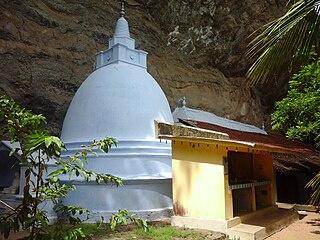
Paramakanda Raja Maha Vihara is an ancient Buddhist temple in Puttalam District, Sri Lanka. The temple is located in Paramakanda village approximately 4 km (2.5 mi) distance from the Anamaduwa town. The site has been formally recognised by the Government as an archaeological site in Sri Lanka. The designations were declared on 1 November 1996 and 6 June 2008 under the government Gazette numbers 948 and 1586.

Magul Maha Viharaya is an ancient Buddhist temple situated in Lahugala, Ampara District of Sri Lanka. The temple lies on the northern edge of the Lahugala National Park, about 22 km off from Siyambalanduwa town and about 11 km off Pottuvil town. Lahugala has been part of the Kingdom of Ruhuna in ancient Sri Lanka. The ruins of Magul Maha Vihara are one of the major tourist attractions of the Eastern province. This temple is also an archaeologically protected monument of the country.

Pusulpitiya Raja Maha Vihara is an ancient Buddhist temple which is located in Pusulpitiya village, Nuwara Eliya District, Sri Lanka. It is situated in Kotmale about 3 miles from Morape on the banks of the Kotmale Oya. Currently this temple has been recognized as an archaeological protected site in Sri Lanka.

Naigala Rajamaha Viharaya is an ancient Buddhist temple situated in Weeraketiya, Hambantota District, Sri Lanka. It is located about 2 km (1.2 mi) away from Weeraketiya junction and 8 km (5.0 mi) from ancient Buddhist temple, Mulkirigala Raja Maha Vihara.

Asgiriya Raja Maha Vihara is an ancient Cave temple situated in Gampaha District, Sri Lanka. The temple is located on top of a hillock on the Gampaha - Minuwangoda road and approximately 2 km (1.2 mi) away from Gampaha town. The temple has been formally recognised by the Government as an archaeological site in Sri Lanka. The designation was declared on 22 November 2002 under the government Gazette number 1264.

Maligatenna Raja Maha Vihara is an ancient Cave temple which is located in Malwatuhiripitiya village, Gampaha District, Sri Lanka. The temple is located on the Gampaha - Wathurugama Road and approximately 1.6 km (0.99 mi) away from the ancient temple Pilikuththuwa Raja Maha Vihara.

Pilikuththuwa Raja Maha Vihara is an ancient Cave temple situated in Pilikuththuwa, Sri Lanka. It is located on the Gampaha - Wathurugama road approximately 3.8 km (2.4 mi) away from the Miriswatta junction and 1.6 km (0.99 mi) from the ancient Buddhist temple, Maligatenna Raja Maha Vihara. The temple has been formally recognised by the Government as an archaeological site in Sri Lanka.
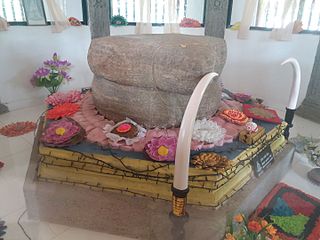
Delgamuwa Raja Maha Vihara is an ancient Buddhist temple situated in Kuruvita of Ratnapura District, Sri Lanka. This temple is reputed as the hiding place of the tooth relic of Buddha during the ruling period of Portuguese in the country.

Kasagala Raja Maha Vihara is an ancient Buddhist Temple, situated in Angunukolapelessa, Hambantota District, Sri Lanka. It is situated about 10 km (6.2 mi) away from Ranna Junction along Ranna - Weeraketiya road. The temple has been formally recognised by the Government as an archaeological site in Sri Lanka. The designation was declared on 6 June 2008 under the government Gazette number 1553.

Uruwala Valagamba Raja Maha Vihara is an ancient Buddhist temple in Uruwala, Sri Lanka. The temple is located on Wathurugama road and approximately 4.71 km away from Miriswatta junction. The temple has been formally recognized by the Government as an archaeological site in Sri Lanka.
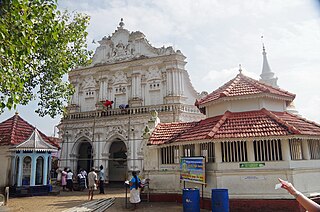
Kande Vihara is a major Buddhist temple in Kalutara District, Sri Lanka. The temple has got its name 'Kande vihara' as it is built on top of a hill located near to Aluthgama town. The temple has been formally recognised by the Government as an archaeological site in Sri Lanka.
Buddama Raja Maha Vihara is a historic Cave temple in Buddama village, Monaragala district, Sri Lanka. Buddama is a rural village lying off Siyambalanduwa town and known as one of early settlements in the country. Currently the temple has been formally recognised by the Government as an archaeological site in Sri Lanka.

Kotte Raja Maha Vihara is a historic Buddhist temple situated in Sri Jayawardenepura Kotte, Western province, Sri Lanka. It is located near to the historic building Pita Kotte Gal Ambalama at the Pita Kotte junction on Kotte road. The temple has been formally recognised by the Government as an archaeological site in Sri Lanka. The designation was declared on 17 May 2013 under the government Gazette number 1811.
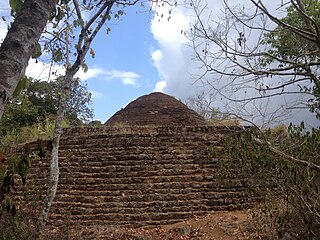
Tomb of Vijaya is an ancient monument, situated on the hillock of Medagama Kanda, Panduwasnuwara DS in Sri Lanka. The monument site consists of a stupa shaped circular structure which is traditionally believed to be the tomb of King Vijaya, the first recorded ruler of Sri Lanka. The hillock of Medagama Kanda lies about 6 km (3.7 mi) south-east of the ancient kingdom, Panduwasnuwara and is surrounded by another two historic temples, Nikasala Aranya Senasanaya and Kande Medagama Raja Maha Vihara. In 2007 the monument was formally recognised by the Government as a protected archaeological site in Sri Lanka.

Muwangala Raja Maha Vihara is an ancient Buddhist temple in Muwangala, Sri Lanka. The temple is located on Hingurana – Ampara road approximately 3 km (1.9 mi) distance from Hingurana town. The temple has been formally recognised by the Government as an archaeological site in Sri Lanka. The designation was declared on 26 December 2014 under the government Gazette number 1895.

Keheliya Raja Maha Vihara is an ancient Buddhist temple in Monaragala District, Sri Lanka. The temple is located in Handapanagala village approximately 11 km (6.8 mi) distance from Wellawaya town. The temple has been formally recognised by the Government as an archaeological site in Sri Lanka. The designation was declared on 22 November 2002 under the government Gazette number 1264.

Kanabiso Pokuna Raja Maha Vihara is an ancient Buddhist temple in Monaragala District, Sri Lanka. The temple is located in Handapanagala village approximately 12 km (7.5 mi) distance from Wellawaya town. The temple has been formally recognised by the Government as an archaeological site in Sri Lanka. The designation was declared on 22 November 2002 under the government Gazette number 1264.































